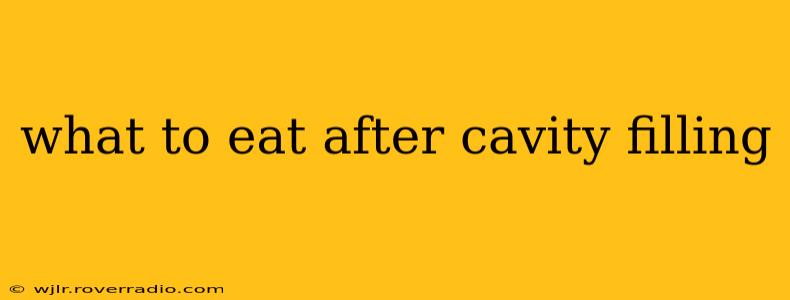What to Eat After a Cavity Filling: A Guide to Safe and Comfortable Recovery
Getting a cavity filled is a common dental procedure, but knowing what to eat afterward is crucial for a smooth recovery. The right diet can minimize discomfort, protect the filling, and promote healing. This guide will cover everything you need to know about your post-filling diet.
What should I eat immediately after a cavity filling?
Immediately following a filling, your mouth might be numb. This is why it’s essential to avoid eating or drinking anything hot, hard, or crunchy until the numbness wears off completely. This prevents accidental biting or damage to the newly placed filling. Stick to soft, cool foods and liquids for at least a few hours. Think yogurt, applesauce, or broth.
Can I eat hard foods after a cavity filling?
This is a frequently asked question, and the answer depends on the type of filling and your individual sensitivity. Generally, it’s best to avoid extremely hard foods like nuts, hard candies, and ice for at least 24 hours. These can potentially damage or dislodge the filling. After the initial 24-hour period, gradually reintroduce harder foods, but always chew on your opposite side to avoid putting pressure directly on the filling.
What foods should I avoid after a cavity filling?
Certain foods should be avoided, at least initially, to protect your filling and prevent discomfort:
- Sticky foods: Sticky sweets like caramel, taffy, and gummy candies can adhere to the filling and potentially pull it loose.
- Chewy foods: Similarly, chewy foods like bagels, tough meats, and licorice can exert excessive force on the filling.
- Very hot or very cold foods: Extreme temperatures can cause sensitivity and discomfort around the filling site. Gradually introduce temperature variations to see what your teeth tolerate.
- Acidic foods and drinks: Acidic substances, like citrus fruits, soda, and tomato sauce, can erode tooth enamel and potentially irritate the filling area. Consume them in moderation and rinse your mouth with water afterward.
What are the best foods to eat after a cavity filling?
The best foods post-filling are soft, easy to chew, and nutritious. Excellent choices include:
- Soft fruits: Bananas, well-cooked peaches, and mashed avocado are all gentle on the teeth.
- Soft vegetables: Well-cooked carrots, sweet potatoes, and squash are nutritious and easy to eat.
- Soups: Broths, pureed soups, and creamy soups are comforting and easy to digest.
- Yogurt and pudding: These provide essential nutrients and are gentle on the gums.
- Scrambled eggs: A great source of protein, easily digestible.
How long should I avoid certain foods after a cavity filling?
While the initial 24 hours are critical, it’s wise to exercise caution for a few days, minimizing consumption of sticky, hard, or overly acidic foods. After a week, you should be able to gradually return to your normal diet, provided you don't experience any discomfort or sensitivity.
What if my filling hurts after eating?
If you experience pain or discomfort after eating, it's crucial to contact your dentist immediately. Pain could indicate a problem with the filling, an infection, or other complications. Don't delay seeking professional help.
Can I drink alcohol after a cavity filling?
Generally, it’s best to avoid alcohol immediately after a filling, especially if you've taken pain medication. Alcohol can interact with certain medications and may also irritate the sensitive area around the filling.
Remember, following these guidelines will aid in a faster recovery and help preserve your new filling. If you have any concerns or persistent discomfort, always consult your dentist for advice tailored to your specific situation. A healthy diet and good oral hygiene are crucial for long-term dental health.
